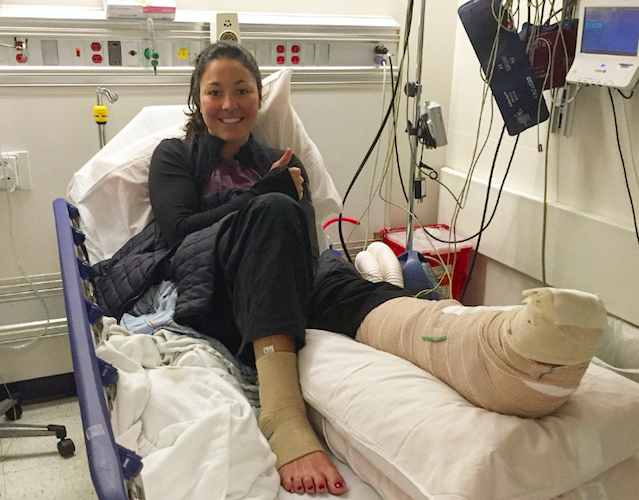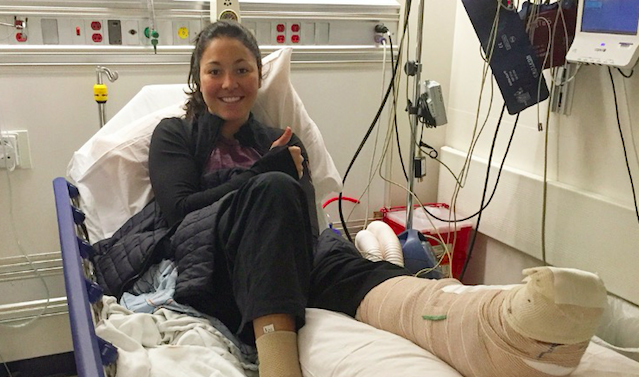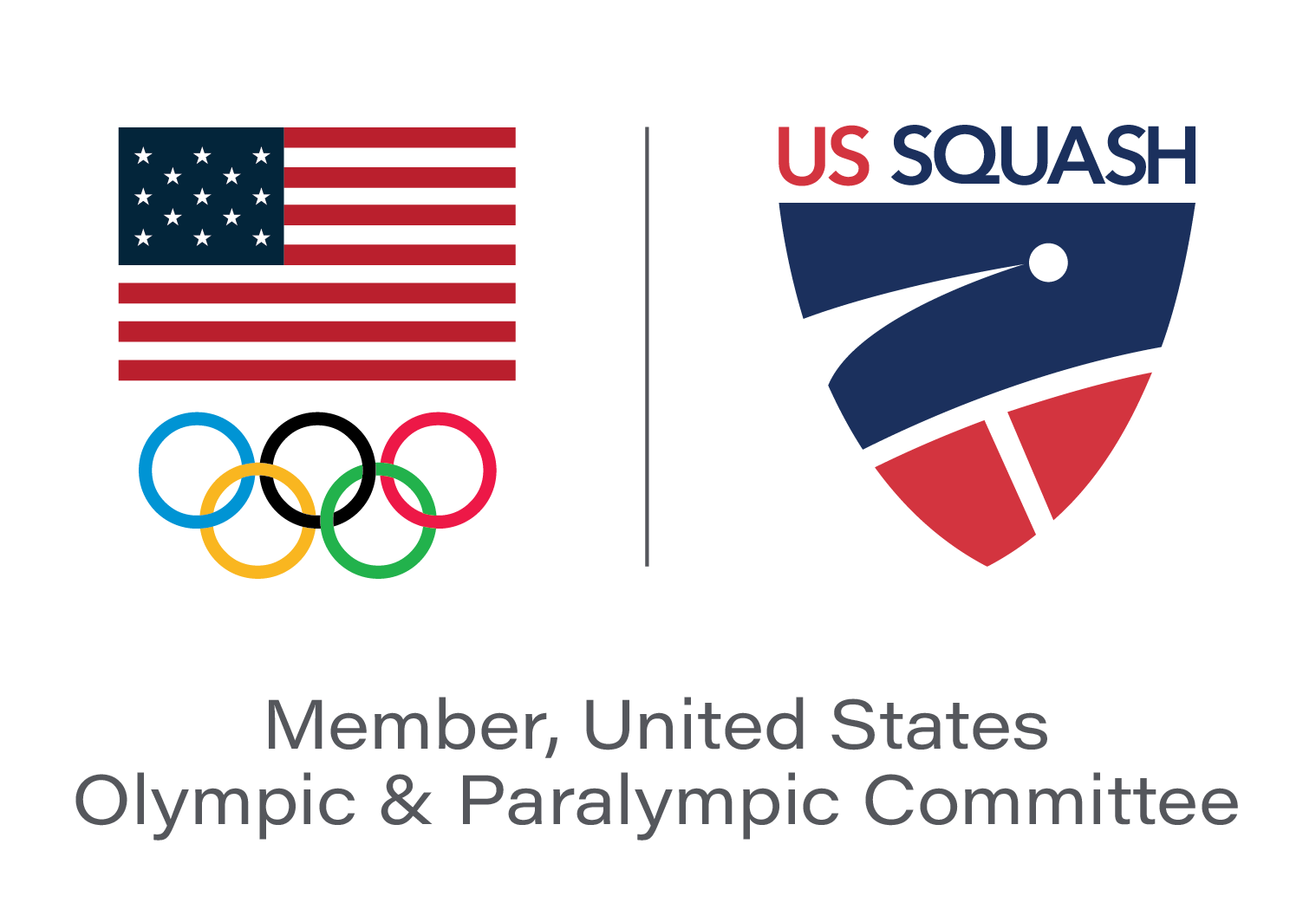
Team USA’s Amanda Sobhy is documenting her recovery process on www.excellesports.com.
by Amanda Sobhy
If you’ve ever been seriously injured, you already know what I’m talking about. And if you haven’t, well, let me tell you. Enduring a debilitating injury is incredibly hard. In fact, it stinks.
The day I snapped my Achilles five weeks ago was the day I embarked on the strongest test of mental strength that I’ve ever had to encounter. For the first month, my entire lower left leg, foot to knee, was trapped in a massive splint, then encased in a cast. It wasn’t until this week when I finally graduated to a walking boot and started “walking” again.
The first few days after I had surgery were manageable. After all, I was on heavy pain medication. And there was a novelty to my injury. My family was around and friends came to visit me at my parents’ home in Sea Cliff, N.Y., where I’ve decided to live while recovering. I enjoyed the attention as I settled into my new phase of life: the Recovery Phase.
I don’t think the severity of my injury or the length of my recovery hit me until five days after surgery. It was then that I grasped the enormity of my situation. For the next four weeks, I would have to rely on my parents to get me food and water, help me shower and carry things for me. I would be sitting all day and, worst of all, I wouldn’t be able work out. How on earth was I going to keep myself busy when I no longer had a training regimen to follow?
Before I got injured, a typical training week consisted of working out twice a day, two to three hours per session, six days a week. Each session focused on either off-court fitness training or on-court squash training. I always pushed myself to the max, leaving nothing behind. My typical training days easily burned up to 3,000 calories.
In between sessions, I was conscientious of eating nutritious food. I’d spread avocado on toast for a pre-training snack, have a protein shake after a workout and then fuel up a few hours later to get ready for my next session. Every human knows that it is imperative to stay hydrated so I would also try to drink at least three liters of water a day. Wake up, hydrate, eat, train, eat, hydrate, train, eat, hydrate, sleep … The cycle was both predictable and absolutely necessary to sustain my life as an elite athlete.
After surgery, my “training” suddenly consisted of crutching from my bed to the couch, where I would remain, forced to keep my leg elevated for 22 hours a day. I knew I still had to hydrate and eat healthy to heal as quickly as possible, but neither activity required the time nor the structure that my training life had demanded. Talk about a shock to the system.
As the realization of my immobility and new injured life hit me, I became acutely aware that getting back to my peak fitness was going to be a humongous task. It seemed daunting and, in my darkest thoughts, impossible to achieve. In a matter of moments, I had gone from being a professional squash player, traveling the world on my own, to being confined to my bed and a couch. I was uncomfortable relying on so many people.
The picture was all wrong. I kept wondering why this had to happened to me. I was a strong and fit athlete. I considered myself to be in shape and healthy. How could I have snapped my Achilles? Where did I go wrong in my training, recovery or preparation?
I knew I had to change my thoughts. The only way to stay strong and sane was to have a positive attitude and develop some sort of routine through my recovery. I like routine, and the fact that I had no structured daily schedule was killing me. So I came up with a plan to help myself stay mentally positive while still focusing on my diet, hydration, sleep and “workouts.”
The first few weeks after I had surgery, while my leg was still in a giant splint, I structured my routine like this: Wake up around 7:30 a.m., drink a liter of water and stay in bed reading or watching Netflix until I was so hungry that I had to crutch downstairs to eat breakfast, which I usually did around 10 a.m. Breakfast was often yogurt with protein powder, berries and nuts, and then I’d go set up camp on the couch in the living room with my books, computer and chargers. I used a knapsack to carry my things around since I was home alone during the week while my parents were at work.
I’d then stay on that one couch with my foot elevated until around 2:45 p.m., when my mom came home from her work as a school music teacher. During that time, I would attempt to work out by doing arm exercises with dumbbells, leg raises and core work. I’d drink a liter of water to stay hydrated and eat lunch around 1 p.m., usually having a turkey sandwich with mustard, avocado and spinach. I’d get help showering when my mom came home for her lunch break, then I’d read, watch TV or think of ways that I could share my story of injury with other people.
Soon after my mom got back, she’d start working again, teaching private flute lessons at home, which meant I had to leave the living room and spend the next few hours confined to my room upstairs, reading, writing, talking to friends or watching Netflix. I would then crutch back downstairs to eat dinner around 6 p.m., staying down for the rest of the night and amusing myself by playing cards or Yahtzee with my parents or watching The Walking Dead or The Voice until it was time for bed. It was a long day of doing nothing, but at least I had developed a routine.
Once I got my splint off two weeks after surgery and was put in a cast, I could start working out in the gym a few days a week, doing one-legged planks, one-legged push-ups, one-legged leg press, core rotations, chest press and—my favorite—the arm bike, otherwise known as the upper-body erg, for cardio. I’d never been so happy to work out.
After almost five weeks on crutches, I have finally graduated to the walking boot. Now, I am starting the walking process again. I feel like a baby taking her first steps and my walking speed closely resembles that of a sloth, but at least I can finally part ways with my crutches. Now begins my four months of extensive physical therapy. And I’m looking forward to it.






